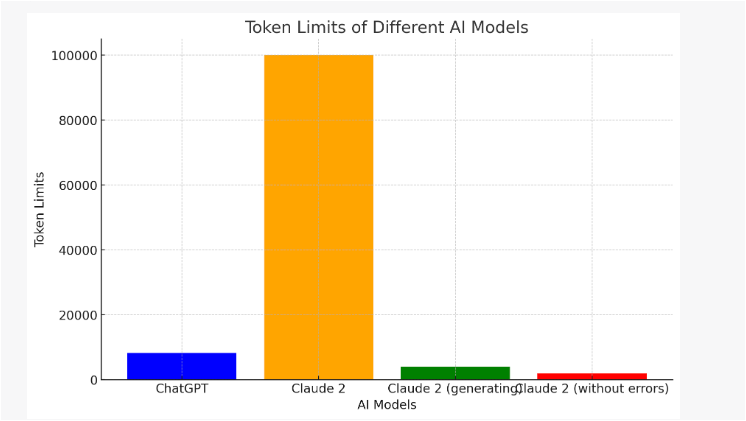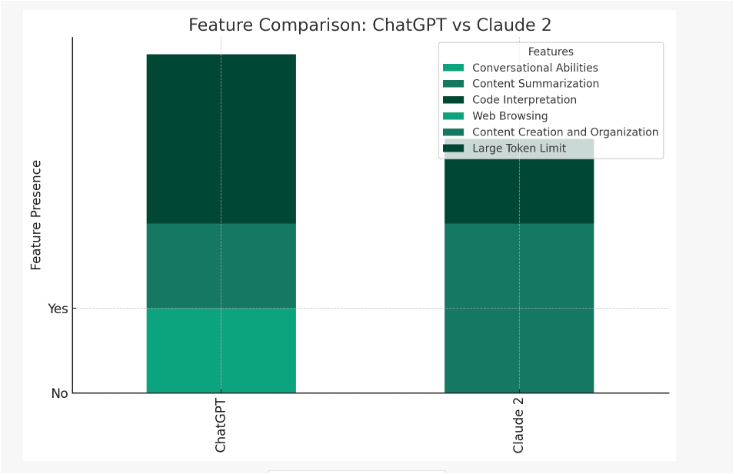
In the world of AI language models, several players have emerged to cater to various needs and preferences.
Among them, ChatGPT, Bard, and Claude 2 have gained recognition for their unique features and capabilities. But which of these AI platforms takes the crown?
If you find yourself wondering which one is worth your time and investment, this article will delve into the strengths and weaknesses of each model to help you make an informed decision.
ChatGPT: Conversational Powerhouse
ChatGPT, based on the GPT-3.5 architecture, is known for its conversational abilities and extensive training on a wide range of topics. It has an impressive knowledge base, but its primary limitation is the knowledge cutoff. Yet, no platform is without its flaws. ChatGPT’s
Achilles heel is its accuracy and the information cut-off date. A small math riddle stumped GPT-3.5, although GPT-4 redeemed itself. When it came to up-to-date information, both faltered, with the cut-off date set to 2021. This means they lack the ability to fetch real-time information.
This means it may not have access to the latest information or events that occurred after that date. One of ChatGPT’s standout features is its ability to summarize long content. For example, it can generate concise bullet points from articles or YouTube videos, making it an efficient tool for content creators and researchers. The GPT-4 model has a 8,192 token limit, allowing for substantial chunks of text to be processed.
However, it’s important to note that this limit may only be available to premium users.
What’s the Big Deal about ChatGPT?
With versions GPT-3.5 and GPT-4, ChatGPT has emerged as a strong contender. Its strength lies in its simplicity, versatility, and its mastery of languages. OpenAI, the organization behind ChatGPT, uses a transformer-based model and an extensive amount of data, giving these chatbots an exceptional ability to grasp language nuances. It’s as if you’re speaking to a real human!

But that’s not all. ChatGPT’s versions are a dab hand at generating HTML and CSS codes. As one user found, it may take a tad bit longer, but the resulting code is a sight to behold. Not quite ready to design a webpage yet? You shouldn’t worry. Just keep nudging it in the right direction, and you’ll find that these chatbots can dial in the code to your specifications.
Pros:
- Exceptional conversational abilities, engaging users in dynamic and interactive conversations.
- Proficient at comprehending and responding to natural language queries.
- Effective at summarizing long-form content, distilling complex information into concise bullet points or summaries.
- Large token limit (8,192 for premium users) enables processing of extensive text.
- Code interpreter feature allows users to execute code snippets for data analysis tasks.
Cons:
- Knowledge cutoff at September 2021, potentially lacking access to the latest information and events.
- Limited web browsing capabilities, relying solely on pre-existing knowledge.
Additionally, ChatGPT’s ability to summarize long-form content is valuable for businesses that need to distill complex information into concise, digestible formats. From summarizing research papers to generating executive briefings, ChatGPT’s summarization capabilities can save time and effort in information processing.
Making it a great tool for Businesses:
- Engaging customers through interactive and personalized conversations.
- Efficient summarization of long-form content for quick insights.
- Enhancing customer support experiences through chatbots.
Bard: Accuracy and Web Browsing Prowess
Bard distinguishes itself by excelling in accuracy, thanks to its built-in web browsing capabilities.
Unlike ChatGPT, which relies on outdated information, Bard can search the web and provide up-to-date answers. It can access recent facts, news, and developments, making it a reliable choice for users who require accurate and current information.
One of Bard’s notable strengths is its ability to summarize long content from web pages, PDFs, or articles. Its summarization feature can help users extract key points and insights quickly.
Additionally, Bard’s accuracy extends to data analysis, with its code interpreter feature enabling the execution of code and providing analysis based on the input.
Pros:
- Exceptional accuracy, providing more reliable and up-to-date information.
- Web browsing capabilities enable access to the latest facts, news, and developments.
- Capable of content summarization from web pages, articles, and PDFs.
Cons:
- Limited availability of web browsing features to the United States and the United Kingdom.
- Relatively lower conversational abilities compared to ChatGPT.
Furthermore, Bard’s content summarization abilities enable businesses to quickly extract key insights from web pages, articles, and PDFs. This capability streamlines research processes, allowing businesses to stay informed and make data-driven decisions.
Businesses mind find it use for:
- Access to up-to-date information and current events.
- Efficient content summarization for research and data extraction.
- Code interpreter for executing code snippets, aiding in data analysis tasks.
Claude 2: Simplifying Content Creation
Claude 2, while still in its early stages, offers promising features for content creation and web browsing. Its interface is user-friendly, allowing users to write and refine articles, outlines, and summaries.
Claude 2 performs well when it comes to refining longer-form content and generating bullet points. It’s a handy tool for writers, bloggers, and researchers who need assistance in organizing and structuring their ideas.
It’s worth mentioning that Claude 2 has a token limit of 100,000, allowing the model to outplay both other models by a large margin.
However, Claude 2’s web browsing capabilities are currently limited to the United States and the United Kingdom, so users outside these regions may not be able to leverage its full potential.
Pros:
- User-friendly interface simplifies the writing, structuring, and organizing of content.
- Ability to generate bullet points and outlines aids in refining written work.
- Valuable for condensing complex information into a more digestible format.
- Potential for future enhancements and improvements.
Cons:
- Limited web browsing capabilities to the United States and the United Kingdom.
- Less mature compared to ChatGPT and Bard, with fewer available features.
- Currently, lacks extensive conversational abilities.
Additionally, Claude 2’s potential for future enhancements makes it an intriguing option for businesses looking to stay at the forefront of AI advancements. As the model continues to evolve, it holds promise for delivering even more robust features and capabilities tailored to business needs.
Pros for Businesses:
- User-friendly interface for easy content creation and organization.
- Efficient generation of bullet points and outlines for structured content.
- Potential for future enhancements and improvements.
The Token Game in AI Models
In our exploration of AI chatbots, token limits play a significant role. Tokens are, essentially, the chunks of text that these models can handle at once. A greater token limit allows for more comprehensive conversations and the ability to process larger amounts of data in one go, an important aspect for businesses seeking detailed insights.
ChatGPT, powered by the GPT-4 architecture, is impressive in this aspect with a limit of 8192 tokens. This allows for extensive and nuanced discussions that can truly dive deep into the heart of any topic. The experience is akin to having an extended debate with a well-informed associate who can discuss any topic at length.
Claude 2, however, ups the ante in this game with a whopping 100,000 token limit – the highest among any commercially available model. This enables businesses to feed Claude hundreds of pages of material to analyze and discuss, facilitating conversations that can go on for hours or even days. Claude 2 is capable of analyzing around 75,000 words, roughly the length of “The Great Gatsby,” and generate about 3,125 words (or 4,000 tokens).

“Please note that the term “tokens” in the context of AI models does not correspond directly to the number of words or characters. In most cases, a token can be as short as one character or as long as one word. But for simplicity, we’ll consider them equivalent in this chart.”
However, it’s worth noting that despite this vast capacity, some users have reported that Claude 2 sometimes struggles to generate more than 2000 characters without mistakes.
Which Reigns Supreme?
With each platform showcasing its strengths and weaknesses, declaring an outright winner is not straightforward. If you’re looking for superior accuracy and real-time data, Bard is hard to beat. On the other hand, if content summarization or coding is your primary need, Claude 2 or ChatGPT could be your best bet.

However, one key factor to consider is accessibility. As of this writing, ChatGPT 3.5 and 4 are available in 163 countries, while Bard serves 230 countries. Unfortunately, Claude 2’s services are limited to the US and UK, which might sway the decision for those living outside these regions.
All in all, there isn’t a definitive one-size-fits-all answer. Your choice will depend on your specific requirements, location, and preferences. While we’ve provided a broad overview here, you may need to test these platforms yourself to find your perfect fit
The Verdict: Which One Is Worth It?

Now that we’ve explored the key features and strengths of each language model, let’s weigh their worth based on specific needs and use cases.
- For Conversational Power: If you’re looking for a language model with strong conversational abilities and the capability to summarize long content, ChatGPT is a solid choice. It can handle a variety of topics and provide concise bullet points from articles or videos. However, keep in mind that it has a knowledge cutoff of September 2021, limiting its access to the latest information.
- For Accuracy and Up-to-date Information: If accuracy and current information are crucial for your tasks, Bard stands out. With its web browsing capabilities, it can search the web and provide real-time answers. Bard is a reliable choice for users who need the most accurate and recent information available.
- For Content Creation and Organization: If your focus is on content creation and organization, Claude 2 offers a user-friendly interface and useful features for refining articles, creating outlines, and generating bullet points. While its web browsing capabilities are limited, it can still assist in streamlining your writing process.
Conclusion
Ultimately, the best language model for you depends on your specific needs and priorities. ChatGPT, Bard, and Claude 2 each have their unique strengths and weaknesses.
If you require conversational abilities and content summarization, ChatGPT is worth considering. Bard excels in accuracy and up-to-date information retrieval, making it ideal for those who require reliable and current facts.
Lastly, Claude 2 simplifies content creation and organization, providing assistance in refining longer-form content.
Note: The views and opinions expressed by the author, or any people mentioned in this article, are for informational purposes only, and they do not constitute financial, investment, or other advice.
Relevant Articles:
Google Magi AI: A New Era in Search and a Race to Stay Ahead
GPT-4’s Leap Into Science: The Mystery of Emergent Abilities
Google’s E-E-A-T Update: Experience Takes the Spotlight

